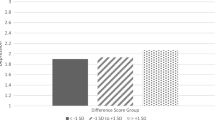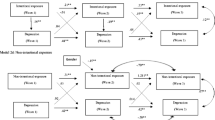Abstract
While most studies on Internet pornography focus on individual’s psychological characteristics, few have explored how social status itself is associated with Internet pornography use. As the Internet is becoming increasingly prevalent, online behaviors may have started to reflect the inequalities of the offline world. This study tested whether lower social status was associated with fewer sexual intercourse opportunities, and whether this led to higher likelihood of using Internet pornography as an alternative means of sexual release. To test the theory, I used the nationally representative sample of the General Social Survey of the U.S. between 2000 and 2004, with missing data handled by chained multiple imputation. The analyses found that lower income, longer working length, being unemployed, or a laborer in the social class strata were associated with fewer sexual intercourse opportunities as measured by three variables: marital status, the number of sex partners, and sex frequency. Lower income, less education, and longer working length were also associated with higher odds of using Internet pornography in the past 30 days, but only income was partially mediated by marital status. Social status was associated with Internet pornography use and sexual intercourse opportunities independently. The comparison of Internet pornography with the traditional X-rated movie found the unique features of Internet pornography use absent for X-rated movie.

Similar content being viewed by others
References
Akers, R., & Sellers, C. S. (2000). Criminological theories (3rd ed.). Los Angeles: Roxbury Company.
Allison, P. D. (2000). Multiple imputation for missing data: A cautionary tale. Sociological Methods & Research, 28(3), 301–309.
Azur, M. J., Stuart, E. A., Frangakis, C., & Leaf, P. J. (2011). Multiple imputation by chained equations: What is it and how does it work? International Journal of Methods in Psychiatric Research, 20(1), 40–49. doi:10.1002/mpr.329.
Barak, A., & Fisher, W. (2002). The future of Internet sexuality. In A. Cooper (Ed.), Sex and the internet: A guidebook for clinicians (pp. 263–280). New York: Brunner/Routledge.
Berard, J. D., Nurnberg, P., Epplen, J. T., & Schmidtke, J. (1994). Alternative reproductive tactics and reproductive success in male Rhesus macaques. Behaviour, 129(3/4), 177–201.
Blau, P. M. (1964). Exchange and power in social life. New Brunswick, NJ: Transaction Publishers.
Brodie, M., Flournoy, R. E., Altman, D. E., Blendon, R. J., Benson, J. M., & Rosenbaum, M. D. (2000). Health information, the Internet, and the digital divide. Health Affairs, 19(6), 255–265.
Buss, D. M. (1989). Sex differences in human mate preferences: Evolutionary hypotheses tested in 37 cultures. Behavioral and Brain Sciences, 12(01), 1–14. doi:10.1017/S0140525X00023992.
Cetron, M. J., & Davies, O. (2005). Trends now shaping the future. IEEE Engineering Management Review, 33(3), 53.
Cooper, A. (1998). Sexuality and the Internet: Surfing into the new millennium. CyberPsychology & Behavior, 1(2), 187–193.
Costa, R., & Brody, S. (2012). Sexual satisfaction, relationship satisfaction, and health are associated with greater frequency of penile-vaginal intercourse [Letter to the Editor]. Archives of Sexual Behavior, 41(1), 9–10. doi:10.1007/s10508-011-9847-9.
Davis, J. A., Smith, T. W., & Marsden, P. V. (2007). General Social Surveys, 1972–2006 [Cumulative File]. Chicago: National Opinion Research Center.
DeNavas-Walt, C., Proctor, B. D., & Lee, C. H. (2005). Income, poverty, and health insurance coverage in the United States: 2004. Washington, DC: US Census Bureau.
Dubuc, C., Coyne, S. P., & Maestripieri, D. (2013). Effect of mating activity and dominance rank on male masturbation among free-ranging male Rhesus macaques. Ethology, 119(11), 1006–1013. doi:10.1111/eth.12146.
Edwards, J. N. (1969). Familial behavior as social exchange. Journal of Marriage and the Family, 31(3), 518–526.
Feingold, A. (1992). Gender differences in mate selection preferences: A test of the parental investment model. Psychological Bulletin, 112(1), 125–139.
Fisher, W. A., & Barak, A. (2012). Internet pornography: A social psychological perspective on internet sexuality. In M. Kimmel & R. Plante (Eds.), Sexuality: Identities, behaviors, and society (pp. 354–368). New York: Oxford University Press.
Graham, R. (2008). The stylisation of internet life?: Predictors of internet leisure patterns using digital inequality and status group perspectives. Sociological Research Online, 13(5), 5.
Greenfield, D., Orzack, M., & Cooper, A. (2002). The electronic bedroom: Clinical assessment of online sexual problems and internet-enabled sexual behavior. Sex and the Internet: A guidebook for clinicians (pp. 129–145). New York: Brunner-Routledge.
Griffiths, M. (2001). Sex on the internet: Observations and implications for internet sex addiction. Journal of Sex Research, 38(4), 333–342. doi:10.1080/00224490109552104.
Grusky, D. B. (2007). Theories of stratification and inequality. In R. G. Malden (Ed.), The Blackwell encyclopedia of sociology (pp. 4809–4818). Malden, MA: Blackwell.
Guttentag, M., & Secord, P. F. (1983). Too many women?: The sex ratio question. Beverly Hills, CA: Sage Publications.
Hanby, J. P., Robertson, L. T., & Phoenix, C. H. (1971). The sexual behavior of a confined troop of Japanese macaques. Folia Primatologica, 16(1–2), 123–143.
Harel, O. (2009). The estimation of R2 and adjusted R2 in incomplete data sets using multiple imputation. Journal of Applied Statistics, 36(10), 1109–1118.
Haworth, A. (2013, October 19). Why have young people in Japan stopped having sex? The Guardian. Retrieved from http://www.theguardian.com/world/2013/oct/20/young-people-japan-stopped-having-sex.
Hayes, B. C. (1995). Religious identification and moral attitudes: The British case. British Journal of Sociology, 46(3), 457–474.
Hirschi, T. (1969). Causes of delinquency (Vol. 47). Berkeley, CA: University of California Press.
Jackman, M. R. (1979). The subjective meaning of social class identification in the United States. Public Opinion Quarterly, 43(4), 443–462. doi:10.1086/268543.
Keegan, M. (2004). Digital divide in computer access and use between poor and non-poor youth. Journal of Sociology and Social Welfare, 31(2), 91–112.
Lawrance, K. A., & Byers, E. S. (1995). Sexual satisfaction in long-term heterosexual relationships: The Interpersonal Exchange Model of Sexual Satisfaction. Personal Relationships, 2(4), 267–285. doi:10.1111/j.1475-6811.1995.tb00092.x.
Lenhart, A., Purcell, K., Smith, A., & Zickuhr, K. (2010). Social media & mobile internet use among teens and young adults. Millennials Pew Internet and American Life Project. Washington, DC: Pew Internet and American Life Project.
Lin, N. (2002). Social capital: A theory of social structure and action. Cambridge: Cambridge University Press.
Luder, M.-T., Pittet, I., Berchtold, A., Akré, C., Michaud, P.-A., & Surís, J.-C. (2011). Associations between online pornography and sexual behavior among adolescents: Myth or reality? Archives of Sexual Behavior, 40(5), 1027–1035. doi:10.1007/s10508-010-9714-0.
Mesch, G. S. (2009). Social bonds and Internet pornographic exposure among adolescents. Journal of Adolescence, 32(3), 601–618.
NORC. (2012). General Social Surveys (1972-2012): Cumulative Codebook Appendix Q: Study Design. Chicago: National Opinion Research Center (NORC).
Ono, H., & Tsai, H.-J. (2008). Race, parental socioeconomic status, and computer use time outside of school among young American Children, 1997 to 2003. Journal of Family Issues, 29(12), 1650–1672. doi:10.1177/0192513x08321150.
Paul, B. (2009). Predicting internet pornography use and arousal: The role of individual difference variables. Journal of Sex Research, 46(4), 344–357.
Peter, J., & Valkenburg, P. M. (2006). Adolescents’ internet use: Testing the “disappearing digital divide” versus the “emerging digital differentiation” approach. Poetics, 34(4–5), 293–305. doi:10.1016/j.poetic.2006.05.005.
Peter, J., & Valkenburg, P. (2007). Adolescents’ exposure to a sexualized media environment and their notions of women as sex objects. Sex Roles, 56(5–6), 381–395. doi:10.1007/s11199-006-9176-y.
Petev, I. D. (2013). The association of social class and lifestyles: Persistence in American sociability, 1974 to 2010. American Sociological Review, 78(4), 633–661. doi:10.1177/0003122413491963.
Rubin, D. B. (1996). Multiple imputation after 18+ years. Journal of the American Statistical Association, 91(434), 473–489.
Sabina, C., Wolak, J., & Finkelhor, D. (2008). The nature and dynamics of Internet pornography exposure for youth. CyberPsychology & Behavior, 11(6), 691–693.
Sapolsky, R. M. (2005). The influence of social hierarchy on primate health. Science, 308(5722), 648–652. doi:10.1126/science.1106477.
Seelye, H. N. (1966). Social behavior of non-human primates in captivity. Science Education, 50(1), 69–75.
Seto, M. C., Maric, A., & Barbaree, H. E. (2001). The role of pornography in the etiology of sexual aggression. Aggression and Violent Behavior, 6(1), 35–53. doi:10.1016/S1359-1789(99)00007-5.
Short, M. B., Black, L., Smith, A. H., Wetterneck, C. T., & Wells, D. E. (2012). A review of Internet pornography use research: Methodology and content from the past 10 years. Cyberpsychology, Behavior, and Social Networking, 15(1), 13–23.
Soltis, J., Thomsen, R., & Takenaka, O. (2001). The interaction of male and female reproductive strategies and paternity in wild Japanese macaques (Macaca fuscata). Animal Behaviour, 62(3), 485–494.
South, S. J. (1991). Sociodemographic differentials in mate selection preferences. Journal of Marriage and Family, 53(4), 928–940. doi:10.2307/352998.
Sprecher, S. (1998). Social exchange theories and sexuality. Journal of Sex Research, 35(1), 32–43. doi:10.1080/00224499809551915.
Sprecher, S. (2002). Sexual satisfaction in premarital relationships: Associations with satisfaction, love, commitment, and stability. The Journal of Sex Research, 39(3), 190–196. doi:10.1080/00224490209552141.
Stack, S., Wasserman, I., & Kern, R. (2004). Adult social bonds and use of internet pornography. Social Science Quarterly, 85(1), 75–88.
Stark, R., & Bainbridge, W. S. (1997). Religion, deviance, and social control. London: Routledge.
Stein, D. J., Black, D. W., Shapira, N. A., & Spitzer, R. L. (2001). Hypersexual disorder and preoccupation with internet pornography. American Journal of Psychiatry, 158(10), 1590–1594.
Thomsen, R., & Soltis, J. (2004). Male masturbation in free-ranging Japanese macaques. International Journal of Primatology, 25(5), 1033–1041.
UCLA: Statistical Consulting Group. (2006). Statistical computing seminars: Multiple imputation in stata. Retrieved August 15, 2013, from http://www.ats.ucla.edu/stat/stata/seminars/missing_data/mi_in_stata_pt2.htm.
U.S. Census Bureau (Producer). (2005). Population 16 to 64 years who have worked in the past 12 months: 2005 American Community Survey. Retrieved January 1, 2015, from http://factfinder2.census.gov/.
van Deursen, A. J., & van Dijk, J. A. (2014). The digital divide shifts to differences in usage. New Media & Society, 16(3), 507–526. doi:10.1177/1461444813487959.
Veblen, T. (1899/2005). The theory of the leisure class: An economic study of institutions. New Delhi: Aakar Books.
Wiederman, M. W. (1993). Evolved gender differences in mate preferences: Evidence from personal advertisements. Ethology and Sociobiology, 14(5), 331–351. doi:10.1016/0162-3095(93)90003-Z.
Wolak, J., Mitchell, K., & Finkelhor, D. (2007). Unwanted and wanted exposure to online pornography in a national sample of youth Internet users. Pediatrics, 119(2), 247–257.
Wright, E. (1980). Class and occupation. Theory and Society, 9(1), 177–214.
Wright, P. J. (2011). U.S. males and pornography, 1973–2010: Consumption, predictors, correlates. Journal of Sex Research, 50(1), 60–71. doi:10.1080/00224499.2011.628132.
Wright, P. J., & Randall, A. K. (2012). Internet pornography exposure and risky sexual behavior among adult males in the United States. Computers in Human Behavior, 28(4), 1410–1416. doi:10.1016/j.chb.2012.03.003.
Wuthnow, R. (2002). Religious involvement and status-bridging social capital. Journal for the Scientific Study of Religion, 41(4), 669–684.
Yang, X. Y., Kelly, B. C., & Yang, T. (2014). The influence of self-exempting beliefs and social networks on daily smoking: A mediation relationship explored. Psychology of Addictive Behaviors, 28(3), 921–927.
Ybarra, M. L., & Mitchell, K. J. (2005). Exposure to Internet pornography among children and adolescents: A national survey. CyberPsychology & Behavior, 8(5), 473–486.
Yoder, V. C., Virden, T. B., & Amin, K. (2005). Internet pornography and loneliness: An association? Sexual Addiction & Compulsivity, 12(1), 19–44. doi:10.1080/10720160590933653.
Young, K. S. (2008). Internet sex addiction risk factors, stages of development, and treatment. American Behavioral Scientist, 52(1), 21–37.
Zimbardo, P., & Ducan, N. (2012). The demise of guys: Why boys are struggling and what we can do about it. Seattle, WA: Amazon Digital Services Inc.
Author information
Authors and Affiliations
Corresponding author
Rights and permissions
About this article
Cite this article
Yang, X.Y. Is Social Status Related to Internet Pornography Use? Evidence from the Early 2000s in the United States. Arch Sex Behav 45, 997–1009 (2016). https://doi.org/10.1007/s10508-015-0584-3
Received:
Revised:
Accepted:
Published:
Issue Date:
DOI: https://doi.org/10.1007/s10508-015-0584-3




